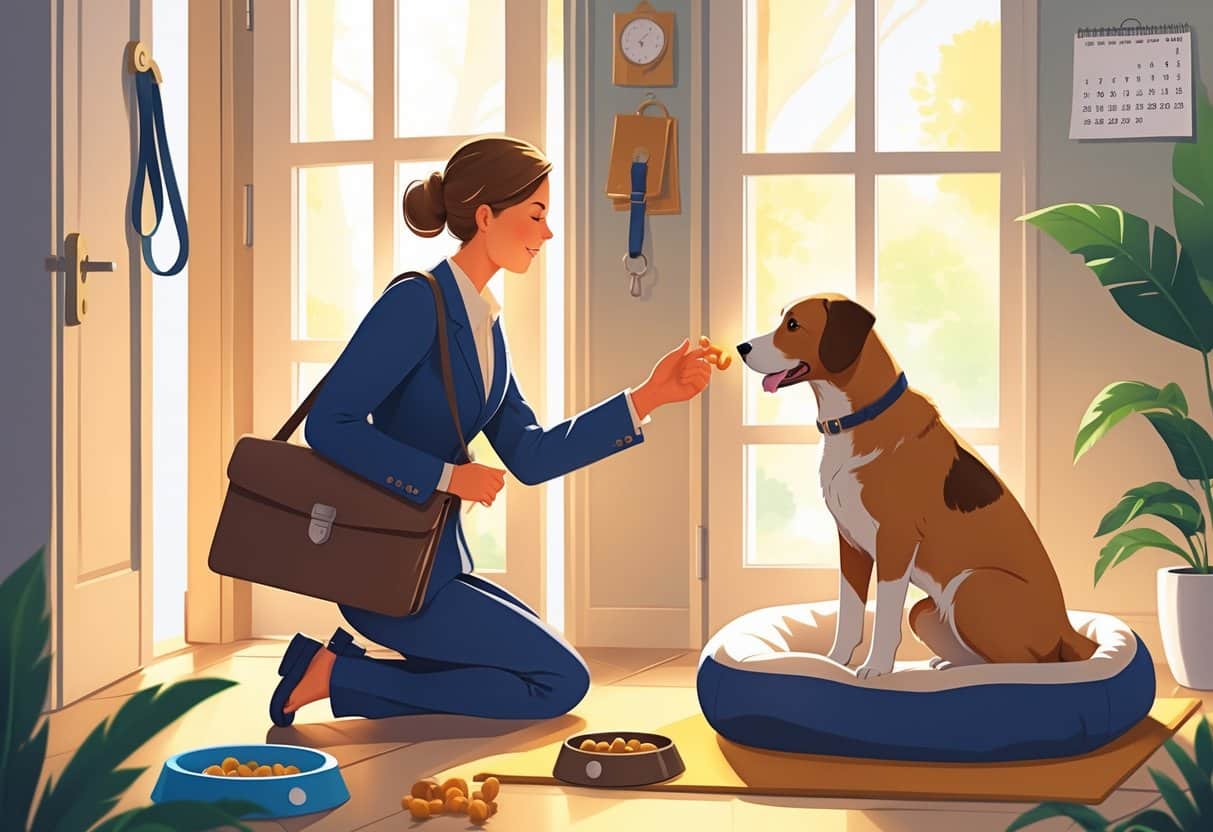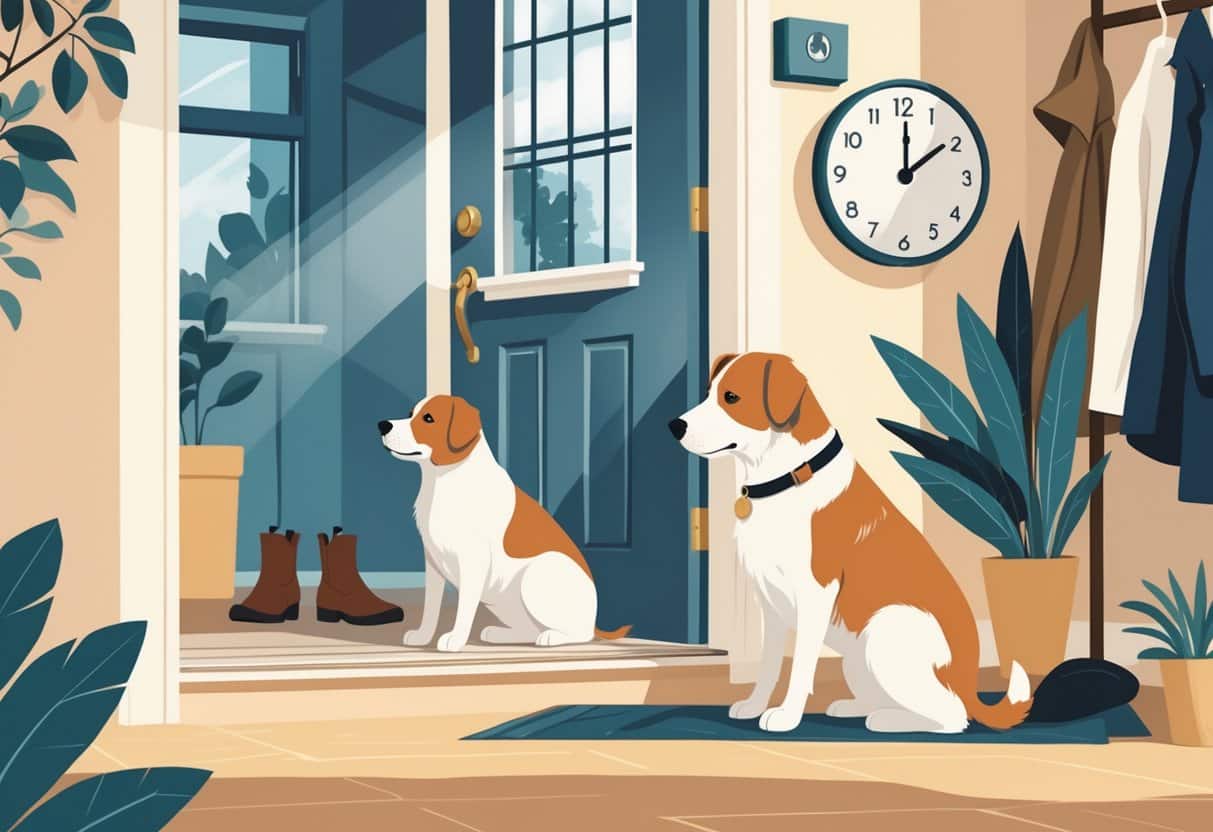
Dogs barking when their owners leave for work is one of those classic pet problems. It stresses out dogs, disrupts households, and, if you’ve got neighbors, might even start a little drama on your street.
The key to stopping excessive barking when leaving for work lies in figuring out if your dog’s barking is about separation anxiety, boredom, or maybe those territorial instincts, then tackling that root cause with consistent training and some smart changes at home.
Dogs bark when left alone for multiple reasons, but separation anxiety is often the main thing going on.
Most dogs can learn to chill out when you leave, but it takes some prep, patience, and a bit of creativity. You’ll need to find what’s really setting off the barking and use a mix of exercise, mental challenges, and positive reinforcement to help your dog cope.
Key Takeaways
- Most dogs bark when left alone due to separation anxiety, boredom, or territorial behavior that can be identified and addressed
- Consistent training with gradual exposure to departures, combined with adequate exercise and mental stimulation, effectively reduces barking
- Creating a calm environment with safe spaces, interactive toys, and routine helps dogs feel secure when their owners leave for work
Understanding Why Dogs Bark When Left Alone
Dogs bark when left alone for a handful of reasons, usually linked to their instincts or emotional needs. The big ones: anxiety from being apart, boredom, territorial vibes, or sometimes even health issues.
Separation Anxiety in Dogs
Separation anxiety affects millions of dogs worldwide and is a leading cause of excessive barking when owners leave. Dogs with separation anxiety don’t just miss you—they can get truly distressed when you’re gone.
Key Signs of Separation Anxiety:
- Barking that starts immediately after the owner leaves
- Destructive behavior like chewing furniture or scratching doors
- Pacing and restlessness before departure
- House accidents despite being house-trained
The barking usually ramps up in the first half hour after you leave. Some dogs will whine, howl, or do weird stuff like spinning or digging too.
Understanding why dogs bark means digging into their emotional and psychological needs. Dogs are social animals—they’re wired for company. Being left alone just isn’t natural for them.
Older dogs might develop separation anxiety more easily, especially if their senses or memory aren’t what they used to be. That can make even familiar places feel less safe.
Boredom and Lack of Stimulation
Boredom is another big reason dogs bark when left alone for hours. Young and high-energy dogs are especially at risk here.
Honestly, a lot of us underestimate how much exercise a dog actually needs. Some healthy young dogs need up to two hours of real activity every day. Two quick walks? Not always enough.
Mental stimulation needs include:
- Problem-solving activities
- Interactive toys
- Training exercises
- New experiences and environments
If a dog doesn’t get enough to do, they’ll often find their own entertainment—and yeah, that can mean barking. Sometimes it just gets worse as the day drags on.
Some breeds, especially the smart or working types like border collies or terriers, need even more mental workouts to keep them from getting bored and noisy.
Territorial and Alert Barking
Dogs are hardwired to guard their turf and warn their pack about anything weird. This instinct can get out of hand if you leave your dog outside or near windows with a good view of the world.
Dogs left outside often decide that guarding territory is their primary job. They’ll bark at just about anything: people, cars, other dogs, delivery trucks—you name it.
Common triggers for territorial barking:
- Mail carriers and delivery personnel
- Other dogs walking by
- Garbage trucks and lawn equipment
- Strangers approaching the property
Even indoor dogs might bark at noises from next door or above. Every footstep or door slam can set them off.
When they can’t actually check out the “threat,” the frustration just builds. Over time, some dogs get more reactive as they practice this routine.
Medical or Health Issues
Sometimes, barking is about physical discomfort or health problems. Pain, aging, or changes in hearing or vision can make dogs more anxious and vocal.
Health conditions that may increase barking:
- Arthritis or joint pain
- Cognitive dysfunction syndrome in senior dogs
- Hearing loss that makes dogs more reactive to vibrations
- Vision problems that increase anxiety
If a dog’s in pain, they might bark more when moving or trying to get comfortable. Older dogs with cognitive decline can get confused and bark out of frustration or stress.
If your dog suddenly starts barking way more than usual, it’s worth checking with a vet. Medical stuff can sneak up on you and make behavior way worse.
Medical issues should always be ruled out with a vet visit if barking behavior suddenly changes or worsens. Catching it early can save everyone a lot of trouble.
Identifying Triggers for Excessive Barking

Dogs often bark when left alone because something specific sets them off—maybe your leaving routine, weird sounds, or even habits they’ve picked up for attention. Figuring out what’s causing it is half the battle.
Departure Cues and Routines
Dogs are sharp—they pick up on departure cues and routines that mean you’re about to leave. Just grabbing your keys or putting on work shoes can make them anxious or jumpy.
Common departure triggers include:
- Picking up keys or wallet
- Putting on work clothes or shoes
- Grabbing a coffee mug or lunch bag
- Setting the alarm system
Some dogs start pacing or whining when they see these signs. Sometimes the barking even starts before you’re out the door.
If you’re not sure what sets your dog off, watch them during your morning routine. Notice when they start looking anxious or making noise.
Signs of departure anxiety:
- Increased following behavior
- Restlessness or pacing
- Whining or soft barking
- Attempting to block the exit
Environmental Noises
Noises from outside often trigger barking in dogs home alone. Without you there to reassure them, every sound can feel like something to worry about.
Most common environmental triggers:
- Delivery trucks and mail carriers
- Other dogs barking in the neighborhood
- Construction or lawn maintenance sounds
- People walking past windows
Barking tends to follow the neighborhood’s daily rhythm. Morning deliveries, lunch hour activity, and late afternoon commutes all seem to set off barking spells.
If your dog hangs out near the window or door, visual triggers plus sounds can make their reaction even stronger.
Peak barking times often occur:
- 9-11 AM (delivery period)
- 12-2 PM (lunch hour activity)
- 3-6 PM (school and work dismissal)
Attention-Seeking Behavior
Some dogs figure out that barking gets them attention. If you’ve ever come back inside or called out to quiet them, they might keep trying it—even when you’re not home.
Barking can become a habit if it’s been rewarded, even by accident. Just popping back in to calm them down can reinforce the pattern.
Signs of attention-seeking barking:
- Barking stops when owner returns
- Dog appears calm between barking episodes
- Barking occurs at specific times when owner usually responds
- No signs of genuine distress or anxiety
This type of barking often starts soon after you leave and drops off when the dog realizes you’re not coming back right away. Sometimes they’ll try again later, hoping for a response.
Reinforcement patterns to avoid:
- Returning when dog barks
- Calling out reassurances through the door
- Extended goodbye routines that create excitement
Pre-Work Strategies to Prevent Barking
Your morning routine can be the difference between a peaceful house and a dog who barks all day. Some exercise, mental games, and sticking to a routine can really help your dog settle when you head out.
Exercise and Mental Stimulation
A tired dog is more likely to rest quietly while their owner is gone.
Dogs need both physical and mental exercise before being left alone for hours.
Physical Exercise Requirements:
- 30-60 minutes of vigorous activity
- Brisk walks or jogging
- Fetch or tug-of-war games
- Dog park visits for social play
The exercise should be intense enough to tire the dog out.
A simple walk around the block just isn’t enough for high-energy breeds, honestly.
Mental Stimulation Activities:
- Basic training commands (sit, stay, down)
- Scent work and nose games
- Short training sessions with treats
- Hide and seek games
Training exercises before departure can tire dogs mentally as well as physically.
Positive reinforcement training tends to work best during these sessions.
The timing matters too—owners should finish exercise 20-30 minutes before leaving.
This gives dogs time to cool down and settle, which is pretty important.
Enrichment Toys and Puzzle Feeders
Interactive toys keep dogs busy and help prevent boredom-related barking.
The trick is to pick toys that last for hours, not just a few minutes.
Long-Lasting Options:
- Kong toys stuffed with frozen treats
- Puzzle feeders for breakfast
- Treat-dispensing balls
- Snuffle mats for nose work
Frozen Kong toys can provide hours of entertainment when filled with peanut butter, yogurt, or wet food.
Freezing makes the treat last much longer—sometimes surprisingly so.
Puzzle feeders serve double duty, providing mental stimulation while slowing down eating.
This can stretch breakfast out to 15-20 minutes instead of just a couple.
Toy Rotation Strategy:
- Keep 3-4 special toys for alone time
- Rotate toys weekly to maintain interest
- Save the best toys only for work days
Regular toys get boring fast.
Special “work day” toys stay exciting because dogs only get them when alone.
Establishing a Calm Routine
Dogs feel more secure with predictable routines.
A consistent morning schedule can help reduce anxiety that leads to barking.
Effective Departure Routine:
- Exercise and mental stimulation
- Breakfast in a puzzle feeder
- Quiet time to settle down
- Calm, brief goodbye
The goodbye should be low-key.
Excited or emotional farewells just ramp up anxiety—so a simple “see you later” is honestly better than a dramatic goodbye.
Environment Setup:
- Close curtains to block visual triggers
- Leave calming music or white noise
- Ensure comfortable temperature
- Provide fresh water
Creating a comfortable, quiet space away from windows helps minimize exposure to outside triggers like delivery trucks or pedestrians.
Some dogs do better when confined to one room, which can prevent pacing and limit stimulation.
The room should have their bed, water, and toys—nothing fancy, just their basics.
Effective Training Techniques
Training a dog to stop barking when left alone takes consistency and a bit of patience.
The most successful approaches focus on gradually reducing anxiety around departures, rewarding calm behavior, and establishing clear communication between dog and owner.
Gradual Desensitization to Owner Absence
Desensitization training can help dogs become comfortable with being alone by slowly increasing separation time.
This method reduces the emotional response that triggers excessive barking.
Start with brief departures of just 30 seconds to 2 minutes.
The owner should leave without making a big deal of it—no emotional goodbyes, no fuss on return.
Gradually extend the time away by small increments.
Increase duration only when the dog stays calm during shorter absences; sometimes that means adding just 5-10 minutes each session.
Practice departure cues like picking up keys or putting on shoes—but don’t actually leave every time.
This teaches the dog those signals don’t always mean abandonment, which can be a relief for them.
The process takes patience and consistency.
Some dogs need weeks or even months to feel comfortable with longer absences—frustrating, but normal.
Positive Reinforcement Training Methods
Positive reinforcement techniques reward dogs for staying quiet and calm during departures.
This approach builds confidence and reduces anxiety-driven barking.
Reward quiet behavior immediately when the dog stops barking or just stays calm.
Use high-value treats, praise, or favorite toys as rewards—whatever really motivates your dog.
Create positive associations with alone time by providing special activities.
Interactive puzzle toys, treat-dispensing balls, or frozen Kong toys are all great options.
Ignore attention-seeking barking completely.
Don’t respond to barking with attention—not even negative attention like yelling, tough as that can be.
Exercise before leaving to tire the dog mentally and physically.
A tired dog is more likely to rest quietly, so aim for 20-30 minutes of activity before departure.
Teaching the Quiet Command
The quiet command gives owners a way to interrupt barking and redirect their dog’s attention.
This technique needs consistent practice and good timing.
Choose a simple command word like “quiet” or “enough.”
Stick to the same word every time, and make sure everyone in the family uses it.
Train during controlled situations first.
Wait for the dog to bark, then say the command and immediately reward when barking stops.
Practice the sequence regularly in different scenarios—start with mild triggers before using the command during real departures.
Never use the command to punish or intimidate.
The goal is communication, not fear. Avoiding punishment makes for better long-term results.
Time the command right as barking starts.
Consistency in timing and rewards helps dogs catch on faster.
Creating a Comfortable Home Environment

A well-designed home environment can reduce barking by addressing your dog’s anxiety and removing visual triggers.
The right setup includes designated safe areas and a few strategic tweaks to limit outside distractions.
Safe Spaces and Comfort Objects
Dogs with separation anxiety feel more secure when they have a designated retreat area.
Creating a comfortable space helps establish a sense of safety when owners leave.
Crate Setup Options:
- High-quality, properly-sized crate with soft bedding
- Open room area with baby gates for boundaries
- Corner space with dog bed and familiar items
The space should include items that smell like the owner.
Used clothing or blankets can provide comfort through familiar scents.
Essential Comfort Items:
- Favorite toys—especially ones used during positive interactions
- Worn clothing—t-shirts or towels with owner’s scent
- Special blankets—designated for the safe space only
Interactive toys help keep dogs mentally engaged during alone time.
Puzzle feeders and treat-dispensing toys can distract from departure anxiety, at least for a while.
The safe space should always be available, even when you’re home.
Dogs learn to associate this area with calm, relaxed feelings—not isolation or punishment.
Minimizing Exposure to Triggers
External stimuli often set off barking episodes in anxious dogs.
Blocking visual distractions can reduce reactive barking when owners are away.
Window Management Techniques:
- Close curtains or blinds completely
- Apply frosted window film to lower portions
- Move furniture away from windows
- Use cardboard barriers as temporary solutions
Background noise can help mask outside sounds that trigger barking.
Television, radio, or white noise machines provide steady audio coverage—sometimes that’s all it takes.
Effective Background Sounds:
- Classical music or calm instrumental tracks
- Talk radio with steady conversation
- White noise machines or apps
- Television programs with minimal loud noises
Room temperature makes a difference too—dogs left in rooms that are too hot or cold just get more stressed.
The chosen room should have minimal foot traffic visibility.
Areas facing busy streets or neighbor activity can trigger barking all day long.
When to Seek Professional Help
Some barking issues just need expert intervention when basic training methods aren’t working.
Professional trainers and veterinarians can provide specialized solutions for persistent barking problems.
Consulting a Professional Dog Trainer
Dog owners should consult a professional trainer or behaviorist when basic training hasn’t reduced excessive barking after 4-6 weeks of real effort.
Professional trainers have the experience to spot complex behavioral triggers that might be easy to miss.
Signs that indicate professional help is needed:
- Barking continues for hours after the owner leaves
- The dog shows destructive behaviors along with barking
- Neighbors have filed complaints about noise
- Previous training attempts have failed
A professional dog trainer will assess the specific situation and create a customized training plan.
They use positive reinforcement techniques that focus on rewarding calm behavior, not punishing barking.
Many trainers offer in-home consultations to see the dog’s environment firsthand.
This lets them identify environmental factors that may be making the barking problem worse.
Veterinary Solutions and Medication Options
Pet owners ought to visit their veterinarian before diving into training advice to identify the root cause first. Medical issues—stuff you might not expect—can sometimes be behind excessive barking in dogs.
Veterinarians are the ones who can really diagnose separation anxiety in dogs and figure out if medication’s needed. Anti-anxiety medications are typically prescribed when:
- The dog shows severe distress symptoms
- Behavioral training alone isn’t effective
- The barking is part of a broader anxiety disorder
Common options like fluoxetine and clomipramine are often used to lower anxiety. These meds usually work best when paired with behavior modification training, not just given on their own.
The vet will also check for medical conditions like hearing problems or cognitive issues that might cause barking. They’ll recommend dosages and keep an eye on how your dog responds to treatment.
Frequently Asked Questions
Dog owners run into all sorts of challenges with training, environmental tweaks, and professional fixes when their dogs bark too much during work hours. Most questions boil down to quick fixes and bigger-picture strategies for a smoother departure routine.
What methods can I use to prevent my dog from barking when left alone at home?
Honestly, exercise is probably the most effective way to cut down barking when you leave. Tired dogs take naps instead of barking, so that pre-work walk or romp is crucial.
Try to give your dog 30-60 minutes of solid exercise before you head out. If you have a high-energy breed, you might need to double that.
Food puzzle toys can keep dogs busy while you’re gone. These interactive toys force dogs to work for their breakfast, and some will spend up to an hour at it.
Reducing visual triggers is key for dogs who bark at stuff outside. Just closing blinds or curtains can make a surprising difference.
Background noise goes a long way, too. TV, radio, or calming music can help drown out doorbells, footsteps, and street noise that might set your dog off.
How can I train my dog to remain calm when I depart for work?
Gradual departure training helps dogs get used to being alone for longer stretches. Start with 5-10 minute absences and slowly ramp it up over a few weeks.
It’s better to practice these short departures a few times each day, not just before you actually leave for work. That way, your dog doesn’t always associate your leaving with being alone for hours.
Keep your departures low-key to avoid triggering anxiety. Avoiding big emotional goodbyes can really help with separation issues.
Try ignoring your dog for 10-15 minutes before leaving. It sets a neutral mood, not excitement that turns into stress.
Give special treats or toys only when you leave. Creating positive associations with your departure cues can make alone time seem like a reward instead of a punishment.
What are effective strategies to reduce my dog’s separation anxiety that causes barking?
Dogs bark when left alone mostly because of separation anxiety. It’s an attachment thing—some dogs just can’t handle you being gone.
Comfort items can help a lot. Tossing an unwashed shirt or pillowcase with your scent into their bed sometimes makes a real difference.
Setting up a crate or a cozy room with comfy bedding gives anxious dogs a den-like safe spot. That sense of security matters.
Counter-conditioning is another trick: pair your leaving with high-value treats or a favorite activity. Over time, your dog may actually look forward to it.
Sticking to a daily routine—same feeding, walking, and leaving times—reduces the uncertainty that feeds anxiety. Dogs really do thrive on predictability.
In tougher cases, anti-anxiety supplements or medication might help. Your vet can suggest calming aids for dogs with more intense separation issues.
Are there any recommended noise-cancellation devices that can deter my dog from barking in my absence?
White noise machines are surprisingly effective at blocking out outside sounds. They create a steady background hum that covers up things like doorbells or traffic.
Sound-masking apps on phones or tablets can be handy, too. Many feature music or nature sounds designed just for anxious dogs.
Leaving the TV or radio on means your dog hears familiar voices and random sounds. Music or TV can drown out outside noises that might otherwise set off barking.
There are even calming music CDs made especially for dogs, using frequencies that promote relaxation. Some folks swear by them for stress-barking.
Sound dampening materials—like thick curtains, carpets, or foam panels—can help cut down on echoes and muffle outside noise. It can make the environment feel much quieter.
How can I modify my dog’s environment to help alleviate barking during the day?
Visual barriers are a real game changer for dogs that bark at outdoor triggers. Closing shades or drapes helps block out stuff your dog can’t reach anyway.
Keeping dogs inside works better than leaving them out in the yard. Dogs left outside often bark to guard their territory—not ideal if you’re hoping for peace and quiet.
Choosing a quiet back room or an area away from busy windows can make a big difference. Less street noise, less temptation to bark.
Rotate different puzzle toys, chews, and feeders to keep your dog entertained. Boredom is a huge reason for daytime barking.
Make sure the temperature’s comfortable—good heating, cooling, and ventilation can help dogs stay calm. Nobody likes being too hot or cold, right?
And don’t underestimate the power of familiar scents. Leaving out a recently worn shirt or a favorite blanket can help your dog feel less alone.
Can professional dog training help in stopping my dog from barking when I’m not at home?
Professional dog trainers have a whole toolkit of techniques for tackling barking that happens when you’re away. Evening and weekend training classes provide mental stimulation that can help dial down daytime anxiety and, with luck, the barking too.
Animal behaviorists step in for the complicated stuff—like separation anxiety that just laughs at basic training. Certified behaviorists can be found through veterinarians or by poking around professional organizations.
Group training classes give your dog a chance to socialize, which can quietly build confidence in anxious pups. Sometimes, dogs that are better socialized just don’t get as wound up when you leave.
Private training sessions are more of a one-on-one thing. Trainers can actually see your dog’s environment and come up with solutions that fit your specific situation instead of just guessing.
Honestly, professional guidance can save you from some classic training mistakes—because who hasn’t made a few?




